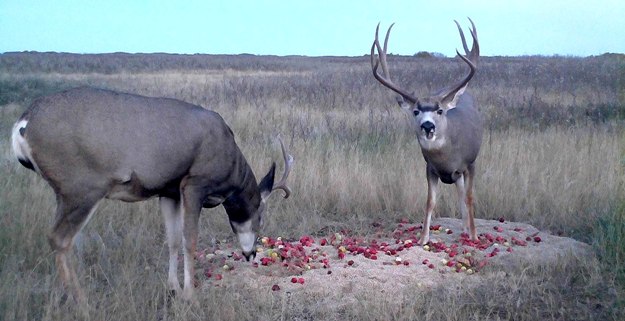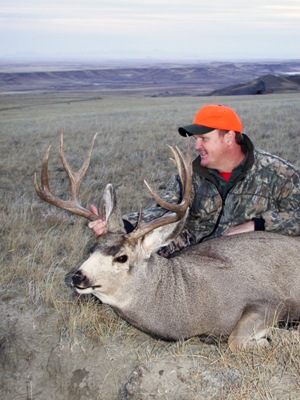
The mule deer is the only big game species in North America that is declining. Many people, especially in the East, never think about mule deer, and they're probably not aware of the declining populations we've had out here in the West, especially in the Northwest. When you say deer in the East, everyone thinks of whitetails. In some areas, the deer are so abundant that they're destroying crops and being hit by automobiles. Often the limits are very liberal. But here in the West, the mule deer is one of the most majestic animals we have. We call them the Icons of the West. They only live in the western part of North America as well as in Canada.
Because I was raised in the West and taught to hunt mule deer by my father, I've always been a spot-and-stalk deer hunter. When I moved to Minnesota, I hunted whitetails there. I didn’t really enjoy sitting in a tree stand or in a ground blind, waiting for a deer to appear. Every year I’d put in for a mule deer tag in North Dakota, so I could hunt with my father the way we always had hunted – spot and stalk.
 When I learned that the mission of the Mule Deer Foundation was to raise funds to improve the habitat of the mule deer, I had to become a part of it. My job as regional director is to work with all the mule deer chapters in Montana and North Dakota to help them raise money to improve habitat for mule deer. I also work with federal and state officials to identify habitat projects with which we can become involved. One of the major problems is that we can’t control the weather, and winter kill is the major factor for the decrease of mule deer populations. So, we try to improve habitat for the mule deer to help them survive harsh winters and have some effect on the predators that kill mule deer.
When I learned that the mission of the Mule Deer Foundation was to raise funds to improve the habitat of the mule deer, I had to become a part of it. My job as regional director is to work with all the mule deer chapters in Montana and North Dakota to help them raise money to improve habitat for mule deer. I also work with federal and state officials to identify habitat projects with which we can become involved. One of the major problems is that we can’t control the weather, and winter kill is the major factor for the decrease of mule deer populations. So, we try to improve habitat for the mule deer to help them survive harsh winters and have some effect on the predators that kill mule deer.
In 2010-2012, our section of the U.S. had three really-hard winters that caused us to lose about 75 percent of the mule deer herds. To try to improve the habitat, we’re very involved in prescribed burning to clean up the litter on the forest floor and encourage new growth. Then the mule deer have plenty of food to build up their bodies to withstand the harsh winters. We also provide money for conifer reduction and for other types of evergreen trees. The conifers are migrating out of the hills and mountains and starting to grow in the plains and kill the grasses that the mule deer need to eat. They also cause many of the stream beds to dry up, because these trees require so much water. As well as conifer reduction, we also help fund conifer thinning in the thick stands of juniper. From the studies done by radio collaring mule deer, we’ve learned that mule deer often won’t go into really thick juniper stands, because they don’t have a quick and easy escape route out of this type of cover.
We also help fund replacing barbed-wire fencing with wildlife friendly fencing that’s barb-less on the top wire and the bottom wire of the fences. The bottom strand of wildlife friendly fencing is usually about 6 inches higher from the ground than regular barbed wire fence to allow antelope and smaller mule deer to go under the fencing. The top two wires are also closer together on this style of fence, so that there is less likelihood of deer and antelope getting their legs caught in the fence when they jump over it. If we define an area where there is a lot of mule deer road kill, we talk with state officials to try and get deer crossing signs put up and to provide access for the deer to either go over the top of the road or under the road.
We also take the lead in working with private landowners to improve their habitat for the mule deer. We basically work with private landowners to improve their land for grazing or improve their land for agriculture. Then all we ask of the landowner is that they open their land to the public for mule deer hunting for X number of years. This program is called PLOTS (Private Land Open to Sportsmen). For instance, there was a 22,000-acre property that never had been open to the public for hunting. When a wildlife biologist heard we were working with private landowners, he came to us. Working with the biologist, we started to improve the land for grazing for the landowner’s cattle. In return, the landowner made his land available for the public to hunt for 10 years. Now, the sportsmen who come to North Dakota to hunt have 22,000 contiguous acres that is open for public hunting that they’ve never been able to hunt before, including 8 miles of Beaver Creek. This is a dream come true for not only the Mule Deer Foundation, but also for the hunters in North Dakota. This project will be one of the conservation projects that I'm most proud of having been involved with. To learn more about the Mule Deer Foundation, you can go to www.muledeer.org.






























